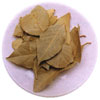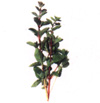Herbs & Spices
 Bay
Leaves Bay
Leaves
In Greco-Roman times, bay leaves
symbolized bravery, wisdom and victory. Its flavor reduces pain,
heals internal injuries, cures skin problems and kills pests. Use in
a wide variety of dishes. Comes from the bay laurel tree which is a
medium-sized evergreen tree, |
|
 Basil Basil
Basil is a member of the mint
family, and was known as the herb of kings in ancient times. In
fact, its name may have been derived from the Greek word
basileus, meaning "king". The ancient Greeks and Romans believed
that you had to curse and yell while you were planting basil, to get
a good crop, although that practice has since been largely
abandoned, at least by commercial growers. Like other members of the
mint family, it has been used medicinally for digestive upsets. Try
making tea from basil, as you would mint, for an after-dinner tea.
Goes well with other herbs, spices and flavorings. |
|
 Sage Sage
Sage is said to preserve youth, get rid
of fat, eliminate odors, prevent decay, aid the intestines and speed
digestion. It is served both fresh and cooked. |
|
 Rosemary Rosemary
Tradition holds that the strong
flavor of rosemary was given to it by Jesus Christ. It is thought to
soothe the nerves, energize the mind and cure headaches, as well as
refresh the body and spirit. It kills all kinds of diseases and
eliminate odors from meats. Used in a wide range of dishes. |
|
 Thyme Thyme
This is a special favorite of southern
France. Thyme, which symbolizes bravery, is said to have
anti-bacterial and preservative properties. It is also good for
coughs and colds, and throat problems. Used in a wide variety of
dishes. |
|
 Oregano Oregano
The Greeks thought that oregano brought
joy to people. It is indispensable in cheese and tomato dishes. A
common herb in Italian dishes, it is used in cooking and roasting
chicken and lamb and eliminates odors from fish. Used in a wide
variety of dishes. |
|
 Mustard
Seeds Mustard
Seeds
There are numerous varieties of mustard
with various levels of heat and sourness. Choose the one you prefer.
Mustard goes well in sausages, beef soups and other meat dishes. It
enhances the texture of a dish. Traditionally, mustard is believed
to reduce inflammation. |
|
 Nutmeg Nutmeg
In medieval England, a handful of costly
nutmeg was equal in value to three lambs. It goes well with both g
round meats and dessert. In China nutmeg is thought to have curative
effects of diseases of the digestive tract. It was also prescribed
for rheumatism. Its side effects include sleeping too much and
addiction. Use sparingly. |
|
 |
|
Background
Today's society is slowly becoming
more and more internationalized. Exchanges of every kind with other
countries are common. As far as food is concerned, a diversity of choices
are available. Under the pressure of increased demand for healthy, high
quality food, both Chinese and Western foods have improved. Food is no
longer just a basic need of human beings, but has become a field of
knowledge and an art in itself. It is hard to imagine what cooking would
be like without the unique flavors available from herbs and spices. For
centuries, they have been an integral part of many of the world's great
cuisines. Today we take for granted those spices over which wars were once
fought. At a time when only kings and other wealthy people could afford
such a delicacy as cinnamon. But today, they are found in almost every
grocery stores and hypermarkets.
The term "spices" is often used
broadly to include all seasonings. Spices come from the bark, roots,
leaves, stems, buds, seeds or fruit of aromatic plants and trees which
usually grow only in tropical countries.
Herbs are soft, succulent plant which
usually grow in the temperate zone. Until recently, cooks have had to make
do with very few fresh herbs such as sage, parsley and thyme. Nowadays,
you can also find fresh basil, coriander, chervil, tarragon, rosemary and
dill easily. Since herbs are at their best when they are young and freshly
picked, it is well worth growing your own.
|
Herbs & Spices Recipes
Related links
|
|
|
 Pepper Pepper
Originally from southern India, Europe
had no spice to match its power, so it was exceptionally expensive
in ancient times. It was considered on par with meat and medicine in
its importance, and an ounce of pepper was worth an ounce of gold.
Peppers generally used include black, white, red and green. Used in
both soups and dishes. |
|
 Saffron Saffron
More valuable than gold, it is the queen
of herbs. From ancient times to today, Europeans have believed it
can refresh the body and awaken the mind. In India and the Far East,
it is thought to eliminate poisons and cure stomach troubles. It is
full of vitamin B2. It increases sweat and brings on menstrual
periods early. As a result, pregnant women are forbidden to consume
saffron. Use in dishes and soups. |
|
 Cinnamon Cinnamon
One of the oldest spice and is native to
Sri Lanka. The spice is the tree bark, rolled into sticks, quills or
ground to powder. In addition to spicing up a dish,
cinnamon disperses heat, stop pain, increases sweat, and gets rid of
colds and nausea. Use in any kind of dish. |
|
 Tarragon Tarragon
Rich in iodine, minerals, vitamins A and
C, it stimulates the appetite and enhances digestion. Use in any
dish. |
|
 Mint Mint
Mint is cool and sweet. In Europe, fresh
mint leaves are soaked in vinegar to create a seasoning for fruits,
salads and cocktails. Mint aids the digestion and cures colds. |
|
 Parsley Parsley
Its leaves are rich in iron, iodine,
minerals, vitamin A and C. In Chinese cooking, it usually appears as
a garnish. |
|
 Fennel Fennel
In the West, in addition to playing an
important role in barbecue sauces and seasonings, it is also used in
bread and desserts and in anchovy sauce. The seeds and leaves are
both edible. Fennel leaves a full feeling and thus is effective for
dieters. |
|
 Marjoram Marjoram
Its unique flavor is much prized. It may
be eaten fresh in salads, and goes well with tomatoes and beans. It
is effective against colds, headaches, fatigue, and diseases of the
digestive tract. It also lowers the blood pressure and soothes the
nerves. Because of its calming effect, it is often used as an aid to
sleep. Simply place dried marjoram leaves inside the pillow. |
|

